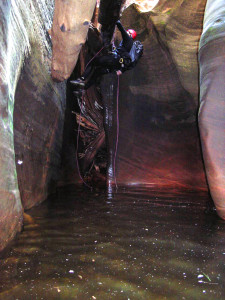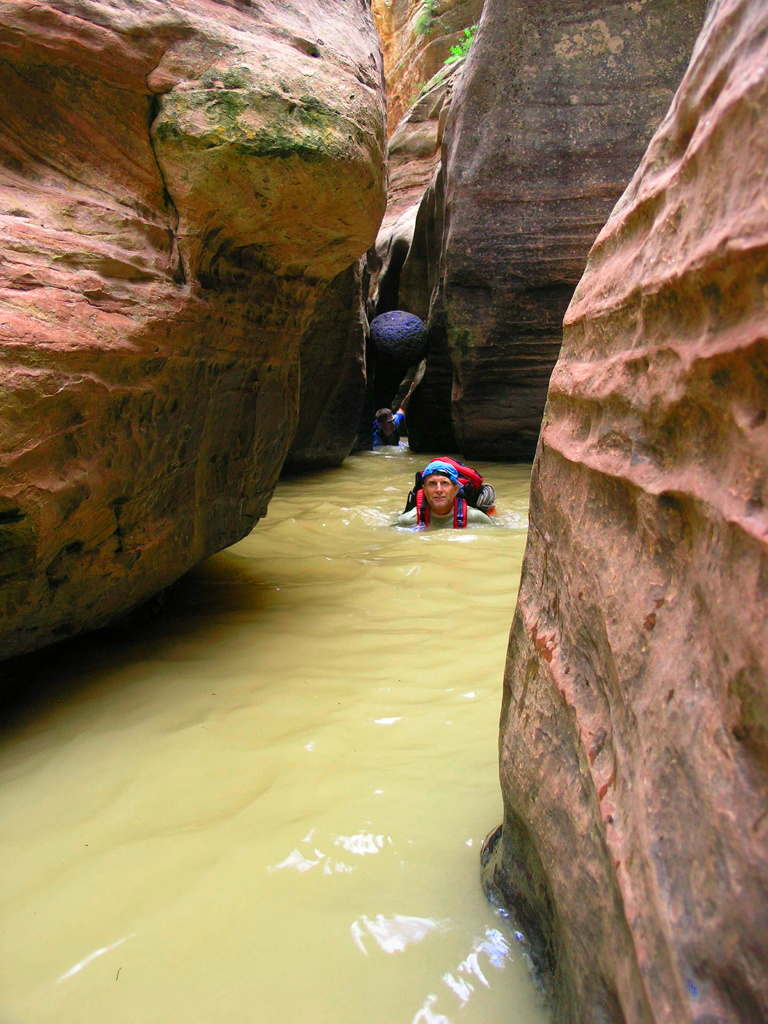
St. GEORGE — Search and rescue crews for Zion National Park were called upon twice Sunday to assist lost and injured people, something they do often enough, already exceeding the number of rescue missions performed by this time last year. In many cases, heeding some basic desert and canyon safety admonitions and understanding even a few survival tips can make all the difference in the adventurer’s experience.
A hiking party got lost and couldn’t find their way out of the Subway slot canyon. Park search and rescue verbally guided them out of the canyon Sunday.
On the same day, an adult female hiker broke her lower leg at Scouts Lookout and an eight-man team carried her to safety in a wheeled litter.

The desert is a beautiful but can be a harsh place to explore, whether by hiking, climbing or canyoneering.
Those who venture out in this landscape need to be prepared for high temperatures, relentless sun, dehydration, navigation, steep terrain and a host of other possible conditions and environmental factors.
The basics
Therese Picard, law enforcement specialist and canyon district ranger in Zion National Park said being prepared with proper footwear, food and water is key to having a safe trip into the desert environment.
Don’t rely on electronics for safety or navigation, Picard said, GPS won’t always be correct. Also, backcountry regions often will not have cell service.
“Basically, having a real map and actually looking at your route and doing a little bit of research,” Picard said, “instead of relying on your cell phone to get you out of trouble.”

Bo Beck, manager of outdoor specialty shop The Desert Rat in St. George, is a former search and rescue volunteer for Zion National Park. Having a map and compass and possessing navigation skills are among the most important factors he lists for desert survival.
“A map gives you the ability to sort of keep yourself on track if for some reason you become disoriented,” he said. “A compass is also a very — if you know how to use it — usable tool in order to assist yourself in getting back to a location.”
Perhaps the most important factor in desert survival is one of the simplest, Beck said, especially for those going solo. He said:
“No. 1 is: … if you’re going by yourself, be certain that you leave an itinerary with somebody who can respond, such as wife or boss or friends. Let them know where or what your plans are, and then set some sort of a timeframe that if you haven’t checked back in within this timeframe, that person knows that there might be a red flag.”
Water is one of the most important aspects to any outdoor adventure in the desert.
Depending on what activity a person is undertaking and how long they plan on being outside, the amount of water needed varies but an absolute minimum, Picard said, is two liters. For all day excursions, a gallon per person is a minimum safe amount.

Above Hildale, Utah, July 2012 | Photo by Joyce Kuzmanic, St. George News
Beck said that knowing where water sources might be located is also essential and can be identified on a map. Carrying some form of water purification system is also recommended as not all water found is safe to drink.
Water sources in the desert can, however, be unreliable. Adventurers should always carry more than they think they will need, Beck said. They should be certain they are hydrated before they go on a trip and should make sure they have plenty of electrolytes to supplement their water intake as they go.
Possibly the most important aspect of safety in desert adventures is to not overestimate one’s abilities. Beck said:
Don’t bite off more than you can chew. If you come to a point that looks particularly difficult — to you — and you’re a bit timid or afraid to conquer that, then by all means let your general common sense determine whether you should (continue) or not, because an injury, particularly solo, could end up pretty tragic.
Going too far on a challenging route does not just put the individual at risk but those with him.
“Even with a partner,” Beck said, “you risk endangering your partner as well by putting them in a complex situation trying to get to you or get you to an area that’s safe. Using common sense is by far the most critical component in desert hiking.”
Search and rescue in Zion on the rise
Search and rescue missions in Zion National Park have been increasing over the years, Picard said. In 2014 there were 81 rescues and 276 medical calls. By 2015, that number had jumped to 105 rescues and 386 medical calls.
“We are already up (in 2016) for the first quarter from where we were last year,” Picard said, adding that the increased visitation is partially to blame for the rise in rescues.
Falls are generally the most common reason to initiate a rescue at Zion, she said, pointing out that by far, most of those in need of rescue are hikers, not extreme athletes.
Another common reason for a rescue is visitors unused to the desert environment. They tend to not bring enough water and are otherwise unprepared for the intense heat and rugged terrain.

Canyoneering concerns
The recent emergency guidance needed for the disoriented Subway party Sunday is a reminder there are canyoneering-specific precautions that can keep those canyoneering safe and on track.
Having a map is important but in the case of areas without trails, such as slot canyons, being able to read the map and decipher what the symbols means are of equal importance.
“The Subway hike, it’s a route, it’s not a trail,” Beck said. “Granted, there is a trail for 1.8 miles, then it becomes a route where it may be marked with cairns — piled rocks — or evidence of wear and tear, footprints and so on, but there are sections where its may be not quite so evident where to go. Studying the route on the map prior to embarking gives you an idea of identifiable landmarks that you need to look for along the way.”
Studying information on slot canyons is something every canyoneerer should do before heading out, he said. It is important not to take this information for granted.
Know the conditions, such as water level and weather before heading out. Seek out more than one source of information.
Even when temperatures are soaring outside the canyon, water in the depths of slot canyons can be cold enough to cause hypothermia – a dangerous condition that can kill. (See symptoms and treatment tips for hypothermia below.)
If a guidebook or website recommends taking wetsuits or extra clothing to get warm once a traveler is out of the water, it is important to heed that advice.
Desert safety tips
- Water: Carry a minimum of 1 quart for every hiking hour or a gallon per person, per day
- Tell someone: Leave a detailed itinerary with friends or loved ones
- Electrolytes: Drinking large amounts of water depletes the body of electrolytes, which need to be replenished
- Food: Carry enough high-calorie nutrients for the planned adventure and for unplanned extended time
- Fire: Have matches on hand – for warmth, boiling water, emergency signals
- Warmth: Have an emergency blanket, be prepared to build a fire
- Whistles: Whistle sound travels much farther than a voice can
- Footwear: Wear proper footwear, properly broken in – don’t wear new boots on a long excursion
- Map and compass: Carry them, know how to use both, do not rely on mobile devices, know how to orient yourself using landmarks
- Study: Prepare for your adventure by studying about the hike or route ahead of time
- Wet in the wild: Carry wetsuits, change of dry clothing if you’re adventuring in slot canyons, rivers, lakes and the like
- Clothing: Choose appropriate clothing for both expected and unforeseen conditions – wear bright colors so you can be easily spotted
- Sunscreen: Take and wear sunscreen
- Know your limits: Exceeding abilities can turn an enjoyable trip into a nightmare; watch your time and bear in mind the return trip
- Reflectors and lights: Carry a mirror and a flashlight – the glint from shiny things can catch the attention of a search party
Signs and symptoms of heat exhaustion and heat stroke
- Heat exhaustion is less severe than heat stroke
- Heat exhaustion includes two types: water depletion and salt depletion
- Water depletion is indicated by extreme thirst, weakness, fainting and headache
- Salt depletion is indicated by nausea, vomiting, dizziness and muscle cramps
- If the symptoms are not addressed swiftly, heat exhaustion can lead to heatstroke
Heatstroke
- Heatstroke is a medical emergency and can kill or cause damage to the brain and other internal organs
- The body often progresses from dehydration to heat exhaustion and eventually to heatstroke
- Heatstroke symptoms include: throbbing headache; dizziness and light-headedness; lack of sweating despite the heat; red, hot and dry skin; muscle weakness or cramps; nausea and vomiting; rapid heartbeat, which may be either strong or weak; rapid, shallow breathing; behavioral changes such as confusion, disorientation or staggering; seizures; and unconsciousness.
- If you suspect someone is experiencing the symptoms of heatstroke, call 911 immediately
- If possible, cool the individual with ice packs or water, and administer first aid
Hypothermia
Signs and symptoms of mild hypothermia include:
- Shivering
- Dizziness, lightheadedness
- Hunger
- Feel nauseated
- Accelerate breathing
- Difficulty speaking
- Mild confusion
- Uncoordinated movements
- Fatigue
- Increased heart rate
As body temperature drops, look for these signs and symptoms of moderate to severe hypothermia:
- Shivering, but when hypothermia worsens, shivering will cease
- Increased lack of coordination
- Slurred speech
- Confusion and poor decision-making, such as trying to remove warm clothes (known as paradoxical disrobing)
- Drowsiness or extreme lack of energy
- Ceases to show concern over condition
- Loss of consciousness
- Weak pulse
- Slow, shallow breathing
Treatment of Hypothermia
When dealing with hypothermia, don’t hesitate, take action. If the victim has lost consciousness, seek medical help immediately. If the person has remained conscious, or when medical help has been sent for for an unconscious victim:
- Get the person to shelter if possible. Be extremely cautious when dealing with unconscious victims, they must be handled gently — their hearts are fragile and sensitive to jarring
- Remove wet clothing, and and get the victim into warm, dry clothes
- Give the person warm — but never hot — drinks. Drinks with a high sugar content are also beneficial. Do not give food to someone with hypothermia
- If possible, get the person to do some form of moderate exercise like walking
- Place unconscious victims (or those who cannot exercise) in a sleeping bag, with a some type of plastic covering (a tarp or plastic sheet) over the top of the bag and place a sleeping pad underneath.
St. George News Editor-in-Chief contributed to this report.
Resources
Email: [email protected]
Twitter: @STGnews
Copyright St. George News, SaintGeorgeUtah.com LLC, 2016, all rights reserved.